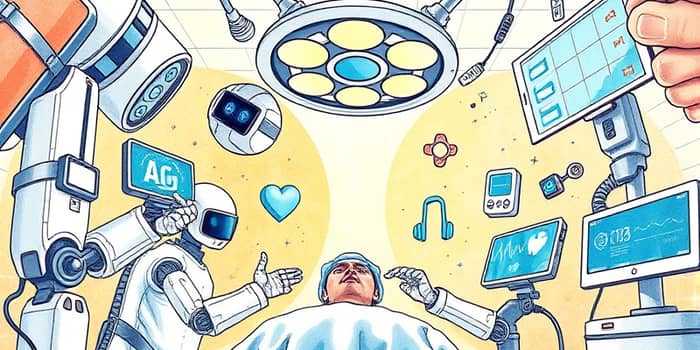In 2025, the healthcare sector is experiencing an unprecedented wave of transformation driven by groundbreaking medical technology innovations. From the rise of artificial intelligence in diagnostics to the shift toward personalized care, the pace of change is accelerating. Stakeholders everywhere are adjusting strategies to capitalize on emerging opportunities, address systemic challenges, and improve patient outcomes.
Market Size and Growth Trajectory
The global medical device market is estimated at $678.88 billion in 2025, reflecting strong demand for advanced diagnostics and surgical tools. Analysts project a projected CAGR of 6% to 2032, driving revenues to over $886.8 billion by the end of the decade. The United States contributes more than 40% of global revenues, underscoring its leadership in innovation and manufacturing.
On the corporate side, US healthcare EBITDA is forecast to grow at 7% CAGR, rising from $676 billion in 2023 to approximately $987 billion by 2028. This robust performance confirms healthcare spending will outpace GDP growth, propelled by demographic trends and rising care complexity.
Investment & Funding Environment
Venture capital activity remains a cornerstone of innovation funding. Although US healthcare VC fundraising reached only $3 billion in H1 2025—the lowest level in more than a decade—private market activity has held firm. Investors continue to seek high-impact opportunities despite public market volatility.
- Healthtech AI deals have ~2x growth in deal activity since 2022.
- Chinese biopharma licensing surpassed $3 billion in H1 2025, outpacing all of 2024.
- Founders cite access to capital and regulatory clarity as critical enablers for scaling breakthroughs.
Optimism remains high, with 87% of sector CEOs/founders confident in sustained innovation and 61% expecting the biotech segment to expand further. This sentiment fuels new startups and strategic partnerships around the globe.
Innovation & Technological Breakthroughs
Artificial intelligence and data analytics have become core drivers of value creation. AI applications extend beyond clinical decision support to administrative efficiency and operational improvement, optimizing workflows and reducing costs. Demand for advanced analytics platforms continues to surge as providers seek actionable insights from vast data streams.
- Digital health adoption climbed from 34% of consumers in 2022 to 43% in 2024.
- Robotic surgery and 3D printing enable personalized procedures and rapid prototyping.
- Wearable monitors and minimally invasive devices boost patient engagement and outcomes.
Meanwhile, breakthroughs in oncology therapies and GLP-1 drugs for weight management are reshaping device portfolios. Early detection technologies and integration of diagnostics with treatment pathways drive demand for comprehensive solutions that blend pharma and medtech.
Strategic Shifts and Market Dynamics
The shift from inpatient to outpatient and home-based care is redefining the medtech landscape. Companies must realign product development, distribution networks, and service models to capture value beyond the hospital setting. This site-of-care migration to ambulatory environments represents both a challenge and an opportunity for next-generation devices.
- 65% of healthcare executives prioritize organic growth through consumer acquisition.
- Mergers and acquisitions surged in late 2024, consolidating capabilities and expanding portfolios.
- Operational barriers include workforce shortages, clinician burnout, and inflationary pressures.
Consolidation strategies are delivering operational synergies and accelerating time to market. However, sustainable success depends on balancing short-term gains with long-term investments in research, talent, and infrastructure.
Building a Robust Ecosystem and Future Outlook
A thriving startup ecosystem underpins continuous innovation. Access to mentorship, research partnerships, and early-stage funding is essential for emerging companies. Policymakers and industry leaders are urged to collaborate on clear, consistent regulatory processes to reduce barriers and fast-track safe, effective products.
Employment impact remains substantial, as the medical device sector supports 2 million jobs globally, including over 300,000 roles in R&D and manufacturing in the United States. Workforce development initiatives and diverse talent pipelines will be key to sustaining this growth.
Looking ahead, organizations that combine strategic agility with patient-centric focus will lead the next wave of progress. By fostering cross-sector partnerships, investing in scalable technologies, and nurturing a culture of innovation, stakeholders can ensure healthcare becomes more accessible, efficient, and personalized for all.
References
- https://www.svb.com/trends-insights/reports/healthcare-investments-and-exits/
- https://wewillcure.com/insights/healthcare-innovation-report
- https://imacorp.com/insights/healthcare-markets-in-focus-q1-2025
- https://www.mckinsey.com/industries/healthcare/our-insights/what-to-expect-in-us-healthcare-in-2025-and-beyond
- https://arterexmedical.com/medical-device-industry-statistics/
- https://www.zs.com/insights/medtech-trends-2025-healthcare-innovation
- https://www.hcinnovationgroup.com/features/document/55284653/state-of-the-industry-report-2025










